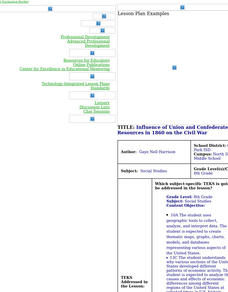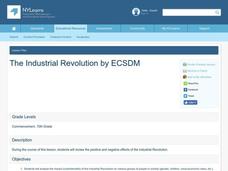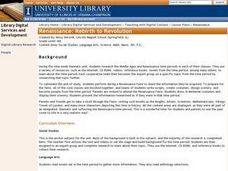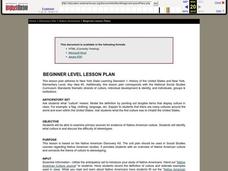Curated OER
Unity Versus Diversity
Young scholars explore the 50 State Quarters program and how it represents diversity and unity of the United States. In pairs, they examine quarter designs to gain information about the culture of each state. Students create charts to...
Curated OER
Keys to Growth in Christ
Students explore ways to grow close to Jesus Christ. For this religious studies lesson, students read and analyze scripture from John, Matthew, and Romans. Students then complete a KWLQ chart based on the readings and write about the way...
Curated OER
Executive Branch of the U.S. Government
Fourth graders create a K-W-L chart of what they know about the executive branch of government. They access the Internet to research a specific level of government. They create a PowerPoint presentation with a minimum of eight slides.
Curated OER
Symposia: Scholarly Parties
Students hold a symposium during which students debate the benefits of democracy in ancient Greece and the United States. By doing this, students explain the role of symposia in ancient Greek culture and politics.
Curated OER
Mayan Culture
Pupils use RAFT prompts to write about Mayan society. In this lesson on Mayan culture, students research and then explain the Mayan hierarchy and social structure. As a culminating activity each student will write a newspaper article...
Curated OER
Tools of the Trade: The Use of Geographic Tools
Students examine the tools of demographic analysis and apply them to real-world situations. They analyze maps, define terminology, and write an information paper for the appropriate government agency to recommend an action or policy change.
Curated OER
Leadership: Leading Off
Students explore leadership skills. In this leadership lesson, students examine leadership styles as they reflect on controversies and celebrations in American baseball. Students discuss the attributes of positive and ethical leaders.
Curated OER
Childhood in Early 19th-Century America
Learners interpret and analyze primary source documents and compare and contrast childhood today with that of the past.
Curated OER
Influence of Union and Confederate Resources in 1860 on the Civil War
Eighth graders compare/contrast population, railroad mileage, manufacturing plants, and industrial workers between the Union and Confederate States in 1860; students analyze effects of the resources of the Union and Confederate Forces on...
Curated OER
George Washington and the Rule of Law
students compare The rule of law with the rule of men and consider life under each of these types of governments.In this government lesson, students read a primary source to examine the importance of the rule of law.They will also answer...
Curated OER
Lewis Hine
High schoolers are be able to analyze primary sources (photographs) of immigration during the early 1900s at Ellis Island. They are be able to identify why immigrants came to America.
Curated OER
Discovery of America
Students examine the European conquest of North America. They participate in activities which allow them to discover the indigenous peoples of the region. They also place events in chrongological order.
Curated OER
The Industrial Revolution
Tenth graders explore the impact of the Industrial Revolution. In this Industrialization lesson, 10th graders take notes on a SMART Board presentation and conduct research on urbanization, enclosure, assembly lines, boarding houses, and...
Curated OER
Jacob Lawrence's Freedom Trail
Students read excerpts of autobiographies from Frederick Douglass and Harriet Tubman. After listening to excerpts of an oral reading of Frederick Douglass' book, they discuss the ways African Americans were treated on plantations. ...
Curated OER
Fairness
Second graders define "fairness." They discuss importance of treating all people with fairness, verbally list way they can be fair to others, and keep track of fairness they see in the classroom by recording incidents on a "Fairness and...
Curated OER
Winter Wonderland: Internet Literature Project
Students, using the Internet, communicate with peers around the world about winter-themed books. They study authors, write book reviews, re-write endings, interview book characters, create scene dioramas, paint murals, and write...
Houghton Mifflin Harcourt
Voyagers: Challenge Activities (Theme 5)
Young voyagers face the challenge of the wide dark sea, travel with Yunmi and Halmoni, and even get trapped by the ice as they explore the reading selections offered in these enrichment activities designed for the Houghton Mifflin...
Curated OER
Civil War Research
Eighth graders research different aspects of the Civil War using various multi-media techniques. Students create a report based on their research that includes views of the war from the point of view of the North, South and slaves.
Curated OER
Community and Colonization
Eighth graders explore the nature of the European colonization in the Americas. They compare how it relates to the inception of their community. Students identify the major players in America's colonization and explore the motivations...
Curated OER
George Washington
For this George Washington worksheet, students answer short answer questions about the first president George Washington. Students complete 6 questions total.
Curated OER
Inventors
Students identify two inventors from the time period 1880-1920. They include information detailing one product or technological advancement each inventor was responsible for. Students use specific language and detail to discuss how...
Curated OER
Renaissance: Rebirth to Revolution
Sixth graders use a variety of resources to research the Middle Ages and Renaissance over a nine-week period. Working in cooperative teams, they become experts on specific topics. Students hold a Renaissance Faire and role-play as...
Curated OER
Native Americans
Students are be able to examine primary sources for evidence of Native American culture. They identify what culture is and discuss the difficulty of stereotypes. Students are given examples of different cultures.
Curated OER
National and Regional Identity
Learners examine state quarters to identify symbols that represent national and regional identity. They discuss the process used to determine what is put on the quarter. They review colonial money, and euros to look for cultural images.







